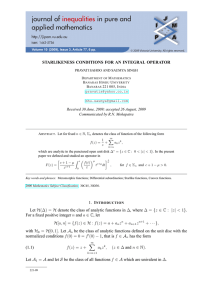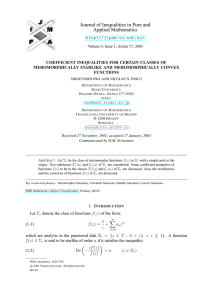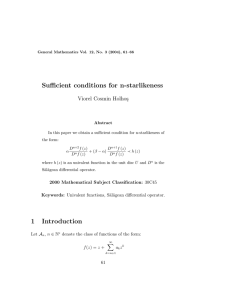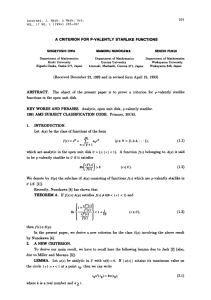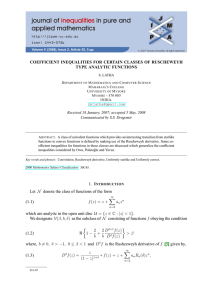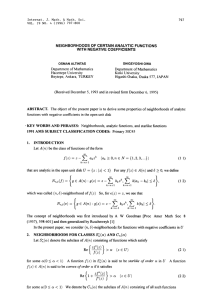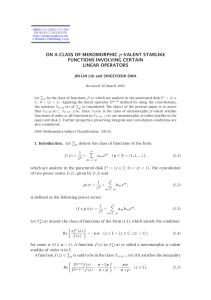FUNCTIONS
advertisement
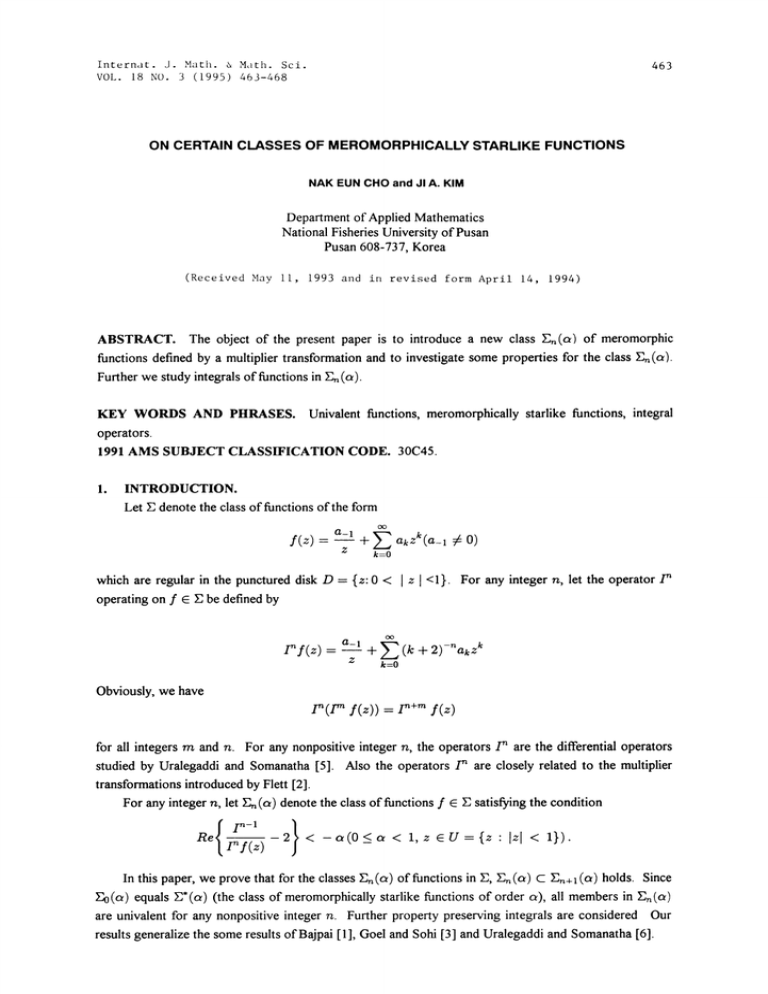
Intern,t. J. Math. & Mth. Sci.
VOL. 18 NO. 3 (1995) 463-468
463
ON CERTAIN CLASSES OF MEROMORPHICALLY STARLIKE FUNCTIONS
NAK EUN CHO and JI A. KIM
Department of Applied Mathematics
National Fisheries University of Pusan
Pusan 608-737, Korea
(Received May 11, 1993 and in revised form April 14, 1994)
ABSTRACT. The object of the present paper is to introduce a new class E,(a) of meromorphic
functions defined by a multiplier transformation and to investigate some properties for the class
Further we study integrals of functions in
KEY WORDS AND PItRASES. Univalent functions, meromorphically starlike functions, integral
operators.
1991 AMS SUBJECT CLASSIFICATION CODE. 30C45.
INTRODUCTION.
Let denote the class of functions of the form
f(z)
which are regular in the punctured disk D
operating on f E :E be defined by
if(z)
a-1
Z
z(_ # o)
+
k=O
{z: 0 <
a_
Z
z
<1}. For any integer n, let the operator
( + .)-z
+
k=O
Obviously, we have
In([ f(z))- j-n+rn f(z)
for all integers m and n. For any nonpositive integer n, the operators/ are the differential operators
studied by Uralegaddi and Somanatha [5]. Also the operators/ are closely related to the multiplier
transformations introduced by Flett [2].
For any integer n, let 2,, (a) denote the class of functions f E E satisfying the condition
In this paper, we prove that for the classes E,(a) of functions in E, E,(o) C E,.I (a) holds. Since
E0(a) equals E*(a) (the class of meromorphically starlike functions of order c0, all members in
are univalent for any nonpositive integer n. Further property preserving integrals are considered Our
results generalize the some results of Bajpai [1 ], Goel and Sohi [3] and Uralegaddi and Somanatha [6].
464
N. E. CHO AND J. A. KIM
MAIN RESULTS.
We begin with the statement of the following lemma due to Miller and Mocaun [4].
LEMMA. Let (u, v) be a complex valued function, D (7, D c (72 E ((7 is the complex
plane), and let u Ul + iu, v Vl + iv:. Suppose that the function (u, v) satisfies the following
2.
:
condition
(i)
(ii)
(iii)
Let p(z)
(u, v) is continuous in D,
(1, 0) E D and Re{C(1, 0)} > 0;
Re{(iu Vl)} < 0 for all (iug. vl)
1
D such that vl < -(1+,)
be regular in U such that (p(z), zp’ (z))
+ Pl z + p z +
U. If
D for all z
(z e U),
Re{(p(z),zp’(z))} > 0
then Re{p(z)} > 0 (z e U).
With the aid of above lemma, we drive
THEOREM 1. Iff E E,(a), then f E E,+l(fl), where
Z=
5 + 2a
PROOF. Define the function p(z) by
If(z)
f’+lf(z)
where
(3- 2a)+
/(3
-
2a)
(2.1)
4
+ (1 -)p(),
V/(3- 2a)
(2.2)
2+s
(2.3)
(’7 >1).
We see that p(z) 1 + Pl z +/9,2z +
is regular in U.
both
differentiations of
sides in (2.2) and using the identity
Making use of the logarithmic
z(Inf(z))’ /n-l f(z) 2/’nf(z),
(2.4)
we obtain
or
-Re
-
lf(z)
2 +a
,+(
,)p(z) +
=Re 2- (a + 9’
(1 -7)zp’(z)
9’ + (1 7)p(z)
(1
7p(z)
Let us define the function (u, v) by
Then (u, v) satisfies
i ontinuou in
(ii)
(1, O) eDandRe{(1,O)}=l-c>O;
(1
7+
(1
(1
(2.5)
7)zp(z)
"
> O. (2.6)
7 + (1 9’p(z)
(2.7)
CLASSES OF MEROMORPHICALLY STARLIKE FUNCTIONS
465
(iii) for all (iu2 ’/31) E .D such that vx < -,1+,z,,2,
Re{q(iu2, v)}
( + 7)
2
< 2- (a + 7)+
7(1 7)v.2
2(’)’ -t-(1 -)
Thus the function (u, v) satisfies the conditions in our Lemma
(z E U), hence
Re
{
I"f(z)
Ir’+x f(z)
}
This shows that
Re{p(z)} > 0
<7(zU
or
where fi is given by (2 l) Therefore we complete the proofofthe theorem
Since
a > 0 in Theorem 1, we have
COROLLARY 1. E,(a) C E,+I (c) for any integer n
REMARK. For nonpositive integers n, Corollary is a similar result obtained by Uralegaddi and
Somanatha [6]
Putting n 0 and a 0 in Corollary 1, we obtain the following result of Bajpai [1]
COROLLARY 2. If f(z)
+ Ek=0az (a-1 :/: 0) is meromorphically starlike, then so is
-
X oZ
F (z)
Next. we prgve
I:ItEOREM 2. Let f
2, (a) and let
F(z)
l’hen
c
tf(t) dr.
c f(t)dt (c
>
t2.11)
O)
Fc F,,, (/3), where
/=
PROOF. Let f
(3 + 2ac)
\/(5
2a
2c) + 8(4c
3
2ac
4
(2.12)
E, (a). Then we have
I n-1 f(z)
}
From the definition of Fc, we obtain
z(I"Fc(z))’ cInf(z) (c + 1)InF (z)
and also
+ 2a)
(2.13)
466
N. E. CHO AND J. A. KIM
(2 15)
Using (2.14) and (2 15), the condition (2 13) may be written as
"-lFc(z)
Re
+
+ (c- 1)
rFlzl
2
(2.16)
7)p(z),
(2.17)
Define the function p(z) by
"7 +
r’F,(z)
(1
where
(7 > 1).
Then p(z)=l+plz+pz2+
simplifying, we have
+ (c 1)
F:(z)
1
is regular in U.
Differentiating (2.17) logarithmically and
-2= -2+7+(1-7)p(z)+
"F()
+ (c- 1) l’a-F(z)
(2.18)
(1
(7 +
7zp’(z)
1) + (1 7p(z)
(2.19)
It follows from (2.19) that
I
Re
+ (c 1)
F,(,)
rF,(z)
l+(c--1) I"Fc(z)
2+a
{
Re 2-(a+7)-(1-7)p(z)-
(1-7)zp’(z)
(7+c-1)+(1-7)P(Z)
}
(2.20)
>0.
If we define the function (u, v) by
(,.)
2
( + 7)
(1 7)
(1
(7 + c- 1) + (1
7)u
then (u, v) satisfies
(C
(u, v)is continuous in D
(ii) (1, O) EDandRe{(1,0)}=l->O;
(iii) for l (iu v) D such that v < -(+
(i)
Re {(iu2, vl)}
(7 + c 1)(1 7)Vl
(7+c 1) 2+(1 -7) 2 u2
c 1)(1 7)(1 + u)
< 2- ( + 7) + (7 +
2{(7 + c- 1) + (1 7)
2
<0.
(a + 7
(2.21)
CLASSES OF MEROMORPHICALLY STARLIKE FUNCTIONS
Since (u, v) satisfies the conditions in Lemma, we have that Re{p(z)}
467
> O(z E U). This proves that
(2.22)
or
Re
"Fc(z)
2
<
(z
C
U),
(2.23)
where is given by (2 12). That is, Fc (z) E, ().
Similarly, from Theorem 2, we have
COROLLARY 3. If f E,(a), then the integral operator Fc defined by (2.11) belongs to the
class E, (a).
Taking n 0 and c 0 in Corollary 3, we obtained the following corresponding result of God and
Sohi [3].
COROLLARY 4. If f(z)
+ akz k is meromorphically starlike, then so is the integral
-
k=0
operator Fc defined by (2.11).
The following theorem gives us a characterization of the class E, (a).
TttEOREM 3. f E,(a) if and only if the integral operator F1 defined by (2.10) belongs to the
class E,_ (o).
PROOF. For c 1, the identities (2.14) and (2.15) reduce to lf(z)= I’-F(z) and hence
I’d-If(z) --/-gl (z). Therefore
r’- f(z)
r-F(z)
Inf(z)
/n-ill (z)
(2.24)
and the result follows.
ACKNOWLEDGEMENT. This paper was supported (in part) by Non-Directed Research Fund and the
Research Institute Attached to University Program, Korea Research Foundation, 1993.
REFERENCES
1.
2.
3.
BAJPAI, S.K., A note on a class of meromorphic univalent functions, Rev. Roumanie Math.
Pure Appl. 22 (1977), 295-297.
FLETT, T.M., The dual of an inequality of Hardy and Littlewood and some related
inequalities, J. Math. Anal. Appl. 38 (1972), 746-765.
GOEL, R.M. and SOHI, N.S., On a class of meromorphic functions, Glas. Mat., 17 (1981),
19-28.
4.
5.
6.
MILLER, S.S. and MOCANU, P.T., Second order differential inequalities in the complex
plane, J. Math. Anal. Appl. 65 (1978), 289-305.
URALEGADDI, B.A. and SOMANATHA, C., Certain differential operators for
meromorphic functions, Houston J. Math., 17 (1991 ), 279-284.
URALEGADDI, B.A. and SOMANATHA, C., New criteria for meromorphic starlike
univalent functions, Bull. Aust. Math. Soc., 43 (1991), 137-140.

